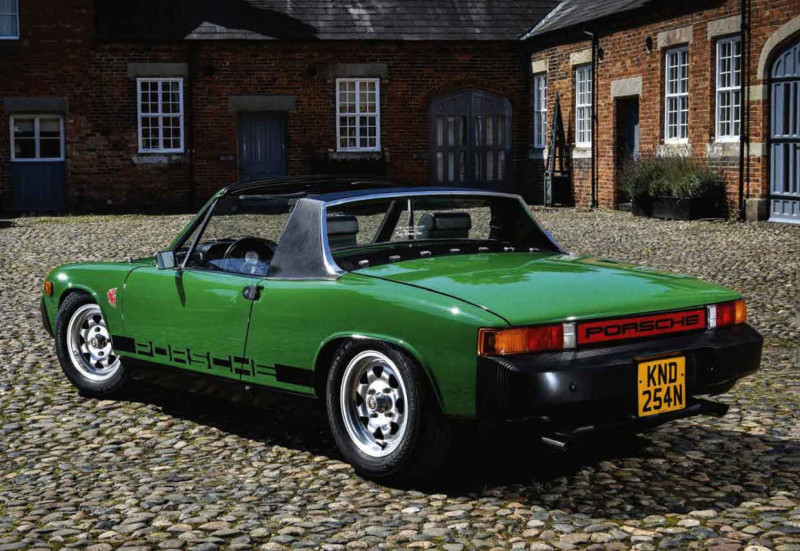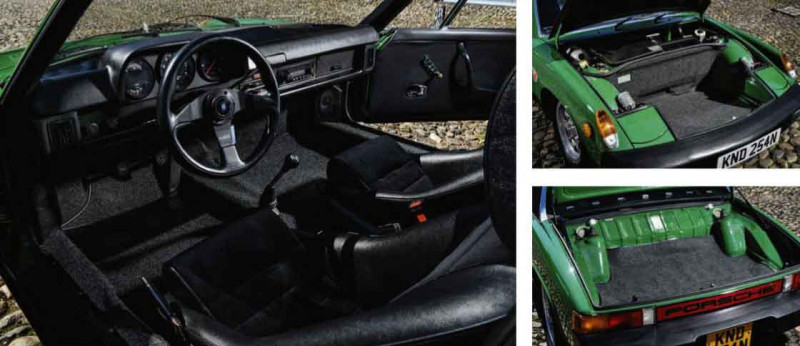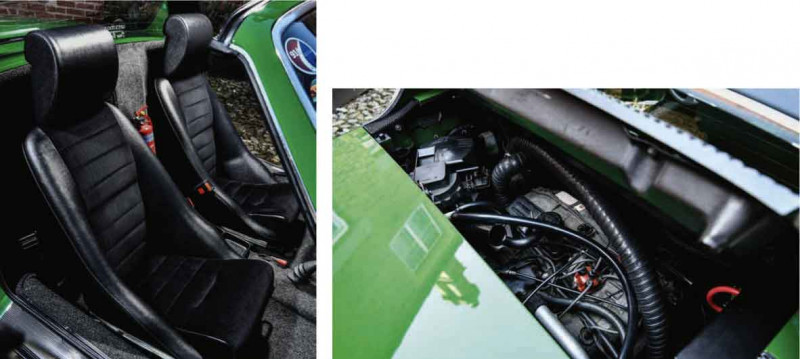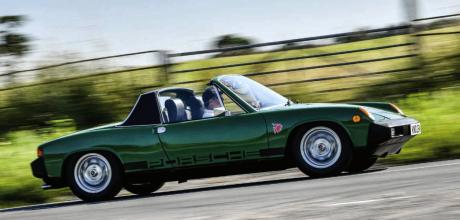1975 Porsche 914/4 1.8 injection US-Spec
Notwithstanding the fact it’s an excellent car in its own right, the 914 remains an affordable entry point to air-cooled Porsche ownership, but be mindful of wearing rose-tinted spectacles if you’re planning to find out what’s available across The Pond… Words Dan Furr. Photography Chris Wallbank.
STATES OF MIND
A superbly recommissioned 1975 Porsche 914 1.8 injection US-Spec
California. It’s the Golden State, where the sun always shines and rain never falls. Well, that’s what many sellers of Stateside classic cars would have eager buyers in Europe believe. In fact, if many of today’s classifieds are to be taken at their word, all classic cars residing in the USA have spent the majority — if not all — of their lives lapping up the warmth of the Pacific coast, their only fault being sun-faded paintwork. In today’s sales terminology, you can expect this to be described as patina, which we’re led to believe is hugely desirable and, consequently, demands your budget to be stretched even further than you’d otherwise anticipated, potentially eating into the money you’d allocated for shipping costs and any applicable import duties. It’s worth it to get a car completely free of rust, though, right?

Sadly, this is an all too familiar fable — patiently awaiting the arrival of their recently purchased classic Porsche from America to European shores, many buyers are often greeted by a vehicle far from the condition they were expecting. Sadly, in some cases, the cost of fixing faults and correcting corrosion not disclosed by the seller can often stack up to more spend than buying a solid example of an air-cooled Porsche in the buyer’s home country, making that ‘cheap’ import something of a false economy. This is especially true of super-old Porsches, including the 356, which may have suffered extensive damage caused by decades of exposure to the elements and bodge repairs carried out when the value of air-cooled cars isn’t what it is today.

“Trust me when I tell you it rains in California,” laughs serial classic Porsche restorer, David Watson. He’s the owner of a recently resurrected 928, a 924 S and a super-rare, factory-built, second-generation flat-nosed 911 Turbo (930) SE. It is, however, his 914 we’ve come to gawp at in the historic grounds of the Combermere Abbey estate, a former monastery now serving as holiday accommodation — and an idyllic countryside wedding venue — between Nantwich and Whitchurch in Cheshire. “My 914 was a West Coast car advertised as a rolling restoration completely free of rust,” he reveals.
“Though the bodywork served as a fairly solid starting point, it was far from being rust-free on arrival in the UK.” Imported from Los Angeles, the Targa-topped two-seater was indeed originally bought by a resident of California (an inhabitant of the promisingly named town of Paradise) and latterly took up sticks in Santa Barbara, but it was clear to David there was much work to be done if the air-cooled Porsche he’d purchased was to live up to the expectations he had after reading the somewhat misleading classified advertising the car as available for purchase weeks earlier.
THE RIGHT INGREDIENTS
Before we find out the condition of the 914 he bought, let’s address the catalyst for his decision to buy this particular flavour of classic Porsche. “There were several reasons I wanted to acquire a 914,” he tells us. “Primarily, I desired a Porsche doer-upper, which, when restored, could be used freely and parked wherever I wanted without much concern for impact on value. Whilst I’m a firm believer owners should regularly use their classic cars, it’s true to say the value of many air-cooled Porsches in the present would make me think twice about piling on the miles. Ultimately, I wanted a fun car I could hop in and drive without hesitation.” Additionally, having been involved in organising trips to the Le Mans Classic for his local car club, David caught sight of 914s (albeit 914/6 GTs, which made use of mid-mounted flat-sixes and were lower and lighter than the same-age 911, resulting in superior handling) running rings around 911s at Sarthe. As many of us can relate to, his fascination for unusual and overlooked cars got the better of him — the hunt for a 914 was well and truly on following his return from France.
The result of a joint venture between Volkswagen and Porsche, the 914 was designed as a replacement for the Karmann Ghia sports coupé. At the same time, the model was heralded as the successor to Porsche’s entry-level model, the 912. Semi-successful on both fronts (but not without its fair share of troubles), the mid-engined marvel is a supremely well-balanced sports car, especially with the 911 T’s two-litre, six-cylinder powerplant burbling away behind occupants’ ears, though almost all 914s were equipped with VW four-cylinder engines. What became known as the baby Porsche was Germany’s best-selling sports car in 1972, and its concept left an indelible impression at Zuffenhausen, so much so that Porsche revisited the 914 format in 1996 for the launch of the Boxster, though considering sales of almost 120,000 914s between model launch in 1969 and discontinuation in 1976, we will never cease to be amazed it took Porsche so long to reintroduce a rear-wheel drive, mid-engined roadster to its product range. While the mixed-parentage 914 is often viewed as Porsche’s ugly duckling, however, few today would argue the distinctively-styled two-seater is anything other than a proper Porsche — with period-perfect looks and a bright colour palette to boot, the little roadster is fast gaining in popularity. Its twin luggage compartments make it perfectly practical, too.
Four-cylinder 914s — known in enthusiast circles as the 914/4 — used VW-derived engines from the 411 and 412 product line. These motors were originally available in 1.7-litre form with K-Jetronic fuel injection and, in 1974, were succeeded by a 1.8-litre model which ran on carburettors in Europe and L-Jetronic fuel injection in the USA. Alongside these punchy four-litre machines, Porsche put the base model 911 T’s two-litre flat-six into just over 3,300 914s between 1970 and 1972. These cars are known as the 914/6. All engines were mated to the 911’s 901 gearbox, but production of a 914/4 and 914/6 differed — while all 914 rolling chassis were built at Karmann’s plant in Osnabrück, cars destined to make use of a six-cylinder engine were transported to Zuffenhausen for final assembly. In contrast, VW engines were installed in-house at Karmann. Production costs proved prohibitively high for Porsche and, as such, a VW two-litre flat-four equipped with D-Jetronic fuel injection became available from 1973, effectively replacing the Porsche engine of the same displacement and only giving away 10bhp to the six-banger. This engine became the only option for final model year production.
On first impression, David’s car, a Zambesi Green 914 first registered in January 1975 and powered by a US-spec 1.8-litre flat-four with L-Jetronic injection, was as described. The damaged windscreen, shabby paintwork and numerous battle scars didn’t generate surprise — all were disclosed by the seller before money changed hands. Even so, a thorough inspection followed the car’s arrival in the UK. “Evaluating the condition of a 914 involves copious amounts of prodding,” David smiles. “Rust is your biggest enemy when buying one of these cars. Rain can fall into the area around the battery tray through the engine cover. If an old lead-acid battery was or is in place, acidic moisture can run down the battery tray to the console underneath, quietly nurturing major rust. In 914 circles, we refer to this as the ‘hell hole’. On initial inspection, my car seemed sound, but behind the seats, the bitumen sound deadening material applied at the factory was just about the only thing holding together the rear floor pan! The metal had rusted away due to a leaking rear screen encouraging moisture to run down the bulkhead, into the cabin and rust the floor from the inside out.” A theme started to develop: David discovered the jacking points to be suspect and the thickness of remaining ‘hell hole’ metal and battery structure were nowhere near as good as first thought. An unanticipated elevenweek holiday at Warrington-based marque specialist, Unit 11, followed, where the offending metalwork was ditched in favour new pattern parts from Restoration Design in Canada and Restoration Design Europe, the company’s European distributor since 2013. As soon as the shell was sound, the flat-four was treated to a full service, the gearbox partially rebuilt (surprisingly, the spigot bearing was missing) and the magnesium casing welded to remedy a small crack. All the gearbox linkages were replaced, too. “The linkage on early 914s isn’t great,” David explains. “It’s not much better on later cars, but replacing all the bushes makes a big difference.”
His lean, green air-cooled machine’s brake calipers were overhauled by Classic Car Automotive and, with the help of fellow members of The Independent Porsche Enthusiasts Club (TIPEC), David replaced all braking system consumables and rewired the car to be UK-compliant. New front and rear European-specification light lenses were fitted, with the US-mandated front side lamps rewired to work as indicators rather than risk further bodywork issues resultant from removing the parts and having the wings refinished. Being a 914 for the 1975 model year, large impact bumpers (required in the USA and specified to all late 914s) were fitted from new. Many owners like to backdate their 914s to wear the more aesthetically pleasing earlier chrome bumper design, but David liked the originality of his car’s chunky black bumpers and reasoned they contrasted nicely with the green bodywork.
Talking of which, a fresh lick of paint was applied by Autobody-craft in Wrenbury, Cheshire, while a new windscreen was delivered direct from Stuttgart for just £220. David is keen, however, to stress to any would-be 914 buyers reading this magazine his car wasn’t a complete restoration. “It was more of a thorough recommissioning project to get the car to a good, usable state,” he says. “To this end, I engaged the services of Kevin ‘Mr 914’ Clarke, Porsche Club GB’s 914 Register Secretary, a walking encyclopaedia of 914 knowledge. He helped me set-up and tune the engine to get it running reliably.”
AROUND THE BENZ
A considered collection of modifications followed. Already slightly lowered over its rare dealer-fit Dan Gurney polished alloys — setting this Porsche apart from the Fuchs or Mahle-riding 914s we see so often — the car was treated to fat Continental tyres and driving lamps, the latter sourced from a Mercedes-Benz R107 SL and installed following careful cutting of blanks in the rubber front bumper. Stainless heat exchangers and a new exhaust were added, while personalisation occurred with the introduction of a Nardi California wood-rimmed steering wheel (originally fitted to David’s first Porsche back in the 1990s) and, more recently, replica 914/6 GT seats manufactured by BF Torino in Italy and supplied by Mark Waring at Rennsport Classics. These bolt directly to the standard 914 subframes and complement the car’s 914/6 bulkhead carpet, a non-standard item in place of the original ‘backpad’. When removing this part for intended refurbishment, David discovered doing so liberated a considerable amount of seat runner travel and legroom, which has proved useful on trips with his exceptionally tall travelling buddy.
A known 914 weakness is the torsion bar rear boot lid springs, which place pressure on the pivots, often requiring rewelding. David replaced these with SGS gas dampers. “The change required minor cutting of the bulkhead, but the SGS parts work very efficiently,” he confirms. The nearby red reflector panel is an aftermarket add-on and was fitted to the car when he bought it. “It covers the original boot lock aperture. I’m considering an electric release mechanism, but for the time being, I’m making use of a lid release cable donated by a kindly Toyota MR2.” The more we chat to him, the more we appreciate how resourceful he is, a trait, perhaps, influenced by the relatively low value of a 914 in the wider context of air-cooled Porsches — the purist approach isn’t necessary, allowing owners to think creatively when it comes to fixes. “Certain trim pieces can be difficult to find and are often expensive, but 914 owners are lucky insofar as most parts required to keep these cars on the road can be sourced fairly easily. The aftermarket is a good place to start, but Porsche Classic also keeps a healthy stock of components for legacy models such as this.”
The original fuel injection system is still in place, though a couple of injectors and the injector seals needed to be renewed. Furthermore, the fuel tank was dropped to replace its fluid transfer hoses with E10-compliant parts. The pump and filters have recently been swapped, though David says reliability has never been much of a concern. “Of all my Porsches, the 914 is the one I use the most. It isn’t by any means the quickest car I own, but its go-kart-like handling is truly addictive. The engine, despite housing just four cylinders, is torquey and loves to rev. Put it this way, on one of my previous trips to Le Mans, I took this car across France in a convoy of other Porsches and the 911 pilots in the group were surprised at just how quick and nimble a 914 is in real-world driving conditions. This car will sit quite happily at 4,000rpm cruising at or above the 70mph mark.”
Another reason David chose a 914 to join his fleet is the ease of maintenance when running a naturally aspirated Porsche of this era. He has been able to perform all routine servicing himself, as well as replacing the oil return tube seals, exhaust, starter motor and numerous other parts from the comfort of his garage. “These are jobs I wouldn’t tackle on a modern car,” he says. “The 914’s link to Volkswagen is a major plus point, of course — a strong supply of regular service items is available for this semi-open- top Porsche.”
A recently sourced period-correct radio sits in the dash, although it’s for show purposes only — a more modern head unit lives in the glovebox, not that the owner of a 914 will want to quiet the noise of an air-cooled engine roaring away behind their ears. Indeed, with a 914 in good overall condition costing from as little as fifteen grand (half that sum for a restoration project), and with a wealth of parts available from a variety of specialists, including everything required for a six-cylinder engine swap for 914s powered by a flat-four, now is an excellent time to get behind the wheel of a tidy example of this low-slung roadster and enjoy the model’s hipswinging chassis dynamics. And if you’re planning to import a 914 from North America to Europe, just be mindful of advertisements hiding the true condition of the car you’re thinking about buying — plan for the worst, hope for the best and you won’t go far wrong.
Above Water can drip through the engine cover and cause rust to form in hidden bodywork cavities Below One of the most affordable entry points to air-cooled Porsche ownership and, if you ask us, one of the most rewarding.
NOW IS AN EXCELLENT TIME TO GET BEHIND THE WHEEL OF THIS LOW-SLUNG ROADSTER AND ENJOY THE MODEL’S HIP-SWINGING CHASSIS DYNAMICS

Above At first glance, the 914 is quite unlike any other Porsche, but the big-selling roadster provided the Boxster blueprint.
Above BF Torino buckets are a replica of the 914/6 GT’s seats and were supplied by Rennsport Classics. Below The 914 is surprisingly spacious and due to mid-mount engine, offers much in the way of luggage room at both ends. Above Chunky US-mandated rubber impact bumpers work well with the Zambesi Green paintwork and black side stripes.
Thanks Peter Beckett at Combermere Abbey Cottages 5-star holiday accommodation (01948 871662) for helping with our photo shoot location.


